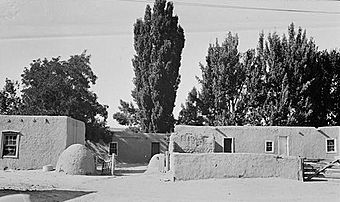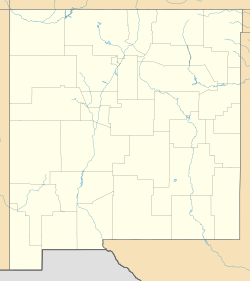San Gabriel de Yungue-Ouinge facts for kids
|
San Gabriel de Yungue-Ouinge
|
|

HABS photo of the site, 1936
|
|
| Nearest city | Española, New Mexico |
|---|---|
| Area | 4 acres (1.6 ha) |
| Built | 1598 |
| NRHP reference No. | 66000482 |
Quick facts for kids Significant dates |
|
| Added to NRHP | October 15, 1966 |
| Designated NHL | July 19, 1964 |
San Gabriel de Yungue-Ouinge, also called San Gabriel de Yunque, was a very important place in early New Mexico history. It was the first capital city for the Spanish in their territory of Santa Fe de Nuevo México. This historic site is found where the Rio Chama river meets the Rio Grande. It is located west of the modern-day Ohkay Owingeh, New Mexico community.
In 1598, a Spanish leader named Juan de Oñate took over the Yuque Yunque pueblo. He then set up his government there. However, the capital was moved to Santa Fe in 1610. Because of its importance, the site was named a National Historic Landmark in 1964. Today, the original archaeological site has been covered over. A special historical marker now stands on the west side of the Rio Grande, near old New Mexico State Road 74.
Contents
A Look Back: History of San Gabriel
The areas of Ohkay and Yunque were home to two related Puebloan communities. The Ohkay settlement likely started around the year 1200 CE. The Yunque settlement began about 100 years later, around 1300 CE. Today, the lands of the Ohkay Owingeh tribe include both of these ancient settlement areas.
Spanish Arrival and the First Capital
When Juan de Oñate arrived in 1598, he wanted to create a Spanish headquarters. He first set up a military camp outside the Ohkay pueblo. He called this place "San Juan." The Ohkay pueblo was known by this name for many years. It only recently took back its original native name in the early 2000s.
The Pueblo people agreed to let the Spanish use the Yunque pueblo. This pueblo was located between the Chama River and the Rio Grande. The people living there moved to the Ohkay pueblo. In the fall of 1598, the Spanish built a church at Yunque. They also dug an acequia, which is a water channel. This channel helped bring water to the Yunque settlement.
The Capital Moves
San Gabriel de Yungue-Ouinge remained the capital of New Mexico until 1610. At that time, a new leader named Pedro de Peralta took over from Oñate. Peralta decided to move the Spanish capital to Santa Fe.
After the capital moved, the Yunque pueblo was mostly left empty by the Spanish. It might have had a few colonists for a short time. However, it was eventually completely abandoned.
Finding the Lost Capital
Historians were always interested in finding the exact location of this early capital. They thought they had found it in the 1890s. In the 1930s, the National Park Service looked at the area. However, they could not be completely sure where the site was.
Later, in the 1940s and 1960s, scientists did special digs called excavations. These digs clearly showed that the area was an early Spanish settlement. They found remains of a church and military buildings. After these digs, local people started taking adobe bricks from the old ruins to reuse them. The site was then leveled and covered over. Today, a cross and a memorial marker show where this important historical site once stood.



